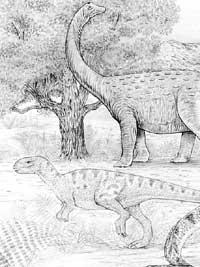The latest advance of Basque Paleontology: new fossil turtles
1996/12/01 Elhuyar Zientzia Iturria: Elhuyar aldizkaria
To organize the biological affinities of beings, in the last two centuries taxonomic classification is used. This organization relates present and past beings as a tree and leads us to know the evolution of all beings. This classification is a stepped hierarchical pyramid. The species are at the most basic level and their whole is the base of the pyramid. Above it is the gender level, followed by the family level, then other levels and, finally, the kingdoms at the top of the pyramid.
Although in recent centuries neontology and paleontology have taken many steps forward, what is still empty in the pyramid is more than what is full. On the other hand, although the pyramid has numerous holes, the location of a new species and, therefore, the placement of a new brick in the pyramid, is a great work and a great immense task; it cannot be said, the higher the pyramid, the more difficult it is to fill the hole. In addition to the new species, the discovery of a new genus or even of a new family represents a great advance, since the discovery occupies the gaps of the three taxonomic levels of the pyramid.

This is what happened with the discovery that two paleontologists from the Museum of Natural Sciences in Paris and the University of the Basque Country have recently published. Paleontologists France de Lapparent de Broin and Xabier Murelaga “Okabixo” have formally recognized various fossil turtles in a prestigious magazine, the Bulletin of the French Academy of Sciences.
The turtles found belong to the land area of the Upper Cretaceous, with an approximate age of 75 million years, and have been excavated at the site of Laño in the County of Treviño. Paleontologists have relied on hundreds of fossil turtle bones and plates to designate the new taxa. Among these fossil turtles are two new families, two new genera and three new species. Thus, the family Dortokidae, the genus Dortoka and the species Dortoka vasconica are new. Also newly created are the family Solemydidae, the genus Solemys and the species Solemys vermiculata. In addition, these paleontologists have discovered the new species Polysternon atlanticum.
Being the vertebrate and scarce turtles, it is very difficult to find new turtle taxa, since the biological scale is also pyramidal; the higher the scale, the less specimens and species exist. For example, insects are more abundant than vertebrates, making it easier to find a new insect species than a new vertebrate species. But there are also differences between vertebrates and turtle has been one of the smallest groups. Moreover, marine vertebrates are more abundant than terrestrial ones and do not forget that Laño turtles are of land.
On the other hand, the scarce knowledge of the species of turtles of the Upper Cretaceous makes this discovery a significant advance in the knowledge of the evolutionary relationships for the phylogeny of turtles, as well as in the paleontological knowledge of Euskal Herria. But, as you can read in the published article, not only are the discoveries, but they have also established their ecological and paleobiogeographic characteristics. On the one hand, two species of these turtles circulated through the rivers, while the third preferred the land, and on the other hand, two species of these turtles have their origin in Gondwana and the third in Laurasia, so the finding shows that these two continents were not yet completely separated.
For all this, it is easy to understand the high degree of discovery made by these paleontologists. Unfortunately, the work they have just published has not been reflected in the ordinary media, despite being a very satisfactory news for Paleontology and the Basque Country.

Gai honi buruzko eduki gehiago
Elhuyarrek garatutako teknologia





